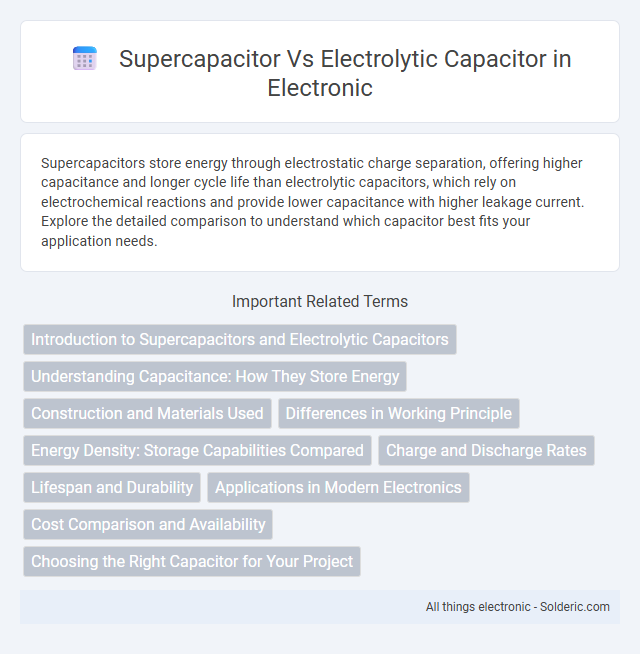Supercapacitors store energy through electrostatic charge separation, offering higher capacitance and longer cycle life than electrolytic capacitors, which rely on electrochemical reactions and provide lower capacitance with higher leakage current. Explore the detailed comparison to understand which capacitor best fits your application needs.
Comparison Table
| Feature | Supercapacitor | Electrolytic Capacitor |
|---|---|---|
| Capacitance | Farads (F) to thousands of Farads | Microfarads (mF) to millifarads (mF) |
| Energy Density | High (up to 10 Wh/kg) | Low (typically less than 0.01 Wh/kg) |
| Voltage Rating | Typically 2.5 V to 3 V per cell | Up to hundreds of volts |
| Charge/Discharge Speed | Fast, suitable for rapid cycles | Fast but limited by ESR and leakage |
| Lifespan | Up to 1 million cycles | 10,000 to 100,000 cycles |
| Leakage Current | Higher leakage current | Lower leakage current |
| Applications | Energy storage, power backup, regenerative braking | Filtering, coupling, decoupling in circuits |
| Size | Larger for given capacitance | Smaller for lower capacitance values |
| Cost | Higher cost per unit capacitance | Lower cost per unit capacitance |
Introduction to Supercapacitors and Electrolytic Capacitors
Supercapacitors store energy through electrochemical double-layer capacitance, offering rapid charge and discharge cycles with high power density, unlike electrolytic capacitors that rely on a dielectric oxide layer for energy storage. Electrolytic capacitors provide higher energy density suitable for filtering and smoothing in power supplies but have limited cycle life and slower response times. Understanding these fundamental differences helps you select the right capacitor type based on performance requirements in applications like energy storage or signal filtering.
Understanding Capacitance: How They Store Energy
Supercapacitors store energy through electrostatic separation of charges in an electric double layer, enabling rapid charge and discharge cycles with capacitance values ranging from farads to thousands of farads. Electrolytic capacitors rely on a thin oxide layer acting as a dielectric between metal plates, typically offering capacitance in the microfarad to millifarad range but with higher energy density than supercapacitors. Your choice between these capacitors depends on whether you prioritize energy storage capacity or high power delivery and quick energy release.
Construction and Materials Used
Supercapacitors utilize activated carbon electrodes with high surface area and an electrolyte, enabling rapid charge storage via electrochemical double-layer capacitance or pseudocapacitance, whereas electrolytic capacitors consist of aluminum or tantalum foil electrodes separated by a paper or polymer electrolyte soaked in an electrolyte solution. The separator in electrolytic capacitors is typically a porous oxide layer acting as the dielectric, contrasting with the thin electric double-layer forming at the interface in supercapacitors. Materials such as activated carbon, graphene, or metal oxides are key to supercapacitor performance, while electrolytic capacitors rely on anodized aluminum oxide for dielectric insulation and electrolyte conductivity.
Differences in Working Principle
Supercapacitors store energy through electrostatic charge accumulation in an electric double layer, enabling rapid charge and discharge cycles with high capacitance. Electrolytic capacitors rely on an electrochemical process involving a thin oxide layer as the dielectric, resulting in higher voltage ratings but slower response times. The fundamental difference lies in supercapacitors' physical charge separation versus electrolytic capacitors' chemical charge storage.
Energy Density: Storage Capabilities Compared
Supercapacitors offer significantly higher energy density compared to electrolytic capacitors, enabling greater energy storage in compact sizes. Your applications benefit from faster charge and discharge cycles and prolonged lifespan of supercapacitors, although electrolytic capacitors can store energy at higher voltage levels. Understanding these storage capabilities allows you to select the optimal capacitor type for energy efficiency and performance needs.
Charge and Discharge Rates
Supercapacitors offer significantly faster charge and discharge rates compared to electrolytic capacitors, enabling rapid energy storage and release ideal for high-power applications. While electrolytic capacitors store more energy per unit volume, their slower charge and discharge cycles limit their use in quick burst or regenerative energy systems. Understanding these differences helps optimize your design for either high-frequency operation or longer-term energy storage.
Lifespan and Durability
Supercapacitors offer significantly longer lifespans and enhanced durability compared to electrolytic capacitors, often exceeding one million charge-discharge cycles without substantial performance degradation. Electrolytic capacitors typically last between 1,000 to 10,000 cycles and are more prone to drying out or leakage, which limits their operational reliability over time. Your choice of capacitor should consider supercapacitors for applications requiring extended durability and frequent cycling.
Applications in Modern Electronics
Supercapacitors excel in energy storage for quick charge-discharge cycles in applications such as backup power systems, wearable electronics, and regenerative braking in electric vehicles, where rapid energy delivery is critical. Electrolytic capacitors are widely used in power supply filtering, smoothing voltage fluctuations in consumer electronics and industrial equipment, due to their high capacitance and voltage handling capabilities. Modern electronic devices increasingly integrate supercapacitors alongside electrolytic capacitors to optimize performance, enhance energy efficiency, and extend battery life in portable gadgets and renewable energy systems.
Cost Comparison and Availability
Supercapacitors typically have a higher initial cost compared to electrolytic capacitors due to advanced materials and manufacturing processes, but their longer lifespan and superior durability often result in lower total cost of ownership. Electrolytic capacitors are widely available and more affordable for large-scale, low-cost applications, making them a cost-effective choice for projects with budget constraints. Your decision should consider both upfront costs and long-term performance requirements when comparing availability and pricing.
Choosing the Right Capacitor for Your Project
Supercapacitors offer high capacitance and rapid charge-discharge cycles, making them ideal for energy storage and power backup applications, while electrolytic capacitors provide higher voltage ratings and compact size suited for filtering and smoothing in power supplies. Selecting the right capacitor depends on factors like required capacitance, voltage rating, size constraints, and application frequency response. Understanding the differences in energy density, leakage current, and lifecycle helps optimize performance and reliability in electronic projects.
supercapacitor vs electrolytic capacitor Infographic

 solderic.com
solderic.com